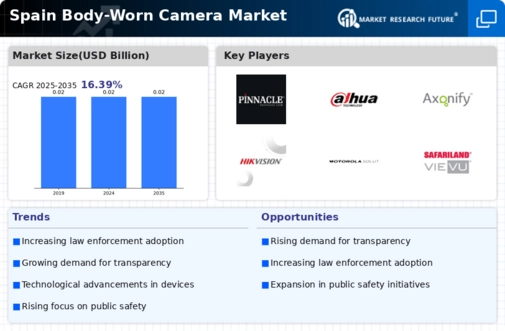Public Awareness and Advocacy
Public awareness and advocacy for the use of body worn cameras are gaining momentum in Spain, significantly impacting the body worn-camera market. Advocacy groups are actively promoting the benefits of these devices, emphasizing their role in enhancing transparency and accountability in law enforcement. Recent surveys indicate that over 60% of the population supports the implementation of body worn cameras, driven by a desire for improved police-community relations. This growing public sentiment is likely to influence policymakers and law enforcement agencies to prioritize the adoption of body worn cameras. As awareness continues to rise, the body worn-camera market may experience increased demand, prompting manufacturers to innovate and expand their offerings to meet the expectations of both law enforcement and the public.
Growing Demand for Accountability
The body worn-camera market in Spain experiences a notable surge in demand for accountability among law enforcement agencies. This trend is driven by increasing public scrutiny regarding police conduct and the need for transparency in law enforcement operations. Recent data indicates that approximately 70% of citizens support the use of body worn cameras to enhance accountability. As a result, police departments are investing in these technologies to foster trust within communities. The body worn-camera market is thus witnessing a shift towards more comprehensive deployment strategies, with an emphasis on training officers to effectively utilize these devices. This growing demand for accountability is likely to propel market growth, as agencies seek to adopt solutions that not only protect officers but also safeguard the rights of citizens.
Support from Government Initiatives
Government initiatives in Spain are playing a pivotal role in shaping the body worn-camera market. Various local and national programs are being implemented to promote the adoption of body worn cameras among law enforcement agencies. These initiatives often include funding opportunities, training programs, and guidelines for effective implementation. For example, recent government reports indicate that funding for body worn camera programs has increased by 30% in the past year, reflecting a commitment to enhancing law enforcement capabilities. This support not only facilitates the acquisition of technology but also encourages agencies to adopt best practices in their deployment. As a result, the body worn-camera market is likely to benefit from sustained government backing, which may further accelerate its growth trajectory in the coming years.
Technological Integration with Smart Devices
The integration of body worn cameras with smart devices is becoming increasingly prevalent in Spain, significantly impacting the body worn-camera market. The advent of advanced technologies such as artificial intelligence and cloud computing allows for enhanced data management and analysis. For instance, the ability to stream live footage to command centers or integrate with existing surveillance systems is gaining traction. This technological synergy is expected to improve operational efficiency and situational awareness for law enforcement agencies. Market data suggests that the adoption of smart technology in body worn cameras could increase by 40% over the next five years, indicating a strong trend towards more sophisticated and interconnected systems. Consequently, this integration is likely to drive further investments in the body worn-camera market, as agencies seek to leverage these advancements for improved public safety.
Rising Crime Rates and Public Safety Concerns
In Spain, rising crime rates and heightened public safety concerns are significantly influencing the body worn-camera market. As urban areas experience an uptick in criminal activities, law enforcement agencies are increasingly turning to body worn cameras as a tool for crime deterrence and evidence collection. Recent statistics reveal that cities with active body worn camera programs have reported a 20% reduction in complaints against police officers, suggesting that these devices may enhance both officer accountability and community trust. The body worn-camera market is thus positioned to grow as agencies recognize the potential of these devices to improve public safety outcomes. This trend indicates a proactive approach to crime prevention, where the deployment of body worn cameras is seen as a critical component of modern policing strategies.





















Leave a Comment